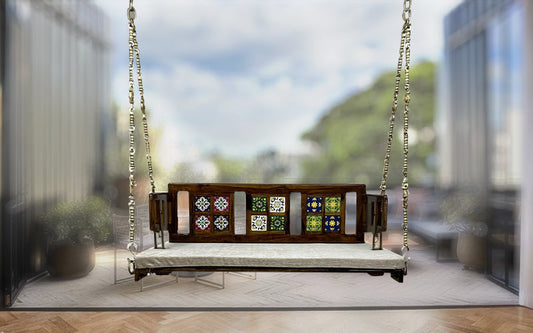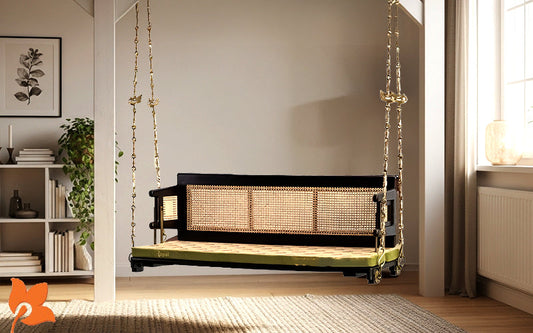
More about the History of Indian Art & Crafts
Discover the Fascinating Story Behind Every Piece You Purchase

Interesting Facts

Upgrade Your Living Area with an Elegant Mahara...
A home feels complete only when it has a space that relax your mind the moment you walk in. For many people, that spot is the living area. It’s where we sit with family, welcome guests, drink our morning tea or sometimes just enjoy our own quiet time. One simple addition that can instantly change the mood of your living room is a Maharaja Swing. This beautiful and royal-style swing is slowly becoming a favorite choice in modern homes not only for its comfort but also for the classic charm it brings. Let’s talk about how adding a Maharaja Swing can upgrade your living space, why it is such a special furniture piece and a few tips to pick the right one for your home. What Makes the Maharaja Swing So Special A Maharaja Swing is not like a normal swing that you see in gardens or parks. It carries the essence of royal Indian design. The name “Maharaja” itself tells you the vibe. These swings usually have carved wooden frames, strong chains as well as a comfortable seat that support your back. They look grand but still blend beautifully with simple and modern interiors. One of the main things people...
Upgrade Your Living Area with an Elegant Mahara...
A home feels complete only when it has a space that relax your mind the moment you walk in. For many people, that spot is the living area. It’s where...

Discover Peace and a Spiritual Bond at Namaste ...
Namaste Mandapam is a simple idea with a big heart. It means a prayer altar in your home where you greet the day, join your palms and invite calm. It can be a small shelf with a diya and a bell, or a full cabinet with drawers, doors and space for idols. The size is not the point but the feeling is. Think of it as your home’s peaceful anchor. When life becomes noisy, this little space reminds you to slow down and breathe. You light a lamp, you chant a few lines, or you just sit in silence. That is enough to reset the mind. Over time, the Namaste Mandapam turns from a piece of furniture into a habit of peace. Why a Prayer Altar Matters Today We all carry screens, alerts, and endless lists in our heads. A prayer altar tells your brain that here the rules change. Here you do one thing at a time. You look at the flame, you listen to your breath, you say your thanks. It is a very small practice, but it builds a very strong bond with something deeper. Many people also feel a stronger link with family and tradition when...
Discover Peace and a Spiritual Bond at Namaste ...
Namaste Mandapam is a simple idea with a big heart. It means a prayer altar in your home where you greet the day, join your palms and invite calm. It...

The Artistic Journey of Pattachitra Paintings
India is famous for its rich cultural heritage and special art traditions, and among them, Pattachitra paintings occupy a special position. This classical art tradition of Odisha and West Bengal is one of the oldest existing styles of paintings in India. Every brush stroke, every hue, and every narration in Pattachitra depicts devotion, mythology & ageless craftsmanship. What is Pattachitra Art? The term Pattachitra is derived from two Sanskrit terms, "Patta" referring to cloth, and "Chitra" referring to picture. So, basically, Pattachitra is "painting on cloth." Pattachitra paintings are famous for their fine detailing, mythological content, and rich natural colors. Conventionally, these paintings narrate mythological stories from Hindu mythology, primarily Lord Jagannath's, Lord Krishna's, and other incarnations of Lord Vishnu's stories. There are also episodes from the Ramayana, Mahabharata, and Odia folklores gorgeously painted in this convention. What sets Pattachitra art apart is its storytelling aspect. Each artwork tells a story of god, painted so intricately and with so much love that it seems to come alive. Artists spend their whole lives honing this art form, teaching the skill to the next generation. The Origins of Pattachitra Pattachitra has its origin more than a thousand years back when the art...
The Artistic Journey of Pattachitra Paintings
India is famous for its rich cultural heritage and special art traditions, and among them, Pattachitra paintings occupy a special position. This classical art tradition of Odisha and West Bengal...

Experience Royal Comfort with Yuvrani Indoor Sw...
Enjoy Royal Comfort with Yuvrani Indoor Swings In todays fast world, we all need that little escape, where we can relax, unwind & put the hustle and bustle of life out of our minds. But what if you could take that bliss right to your home? With a Yuvrani indoor swing, you can convert any room in your home into a calm, royal sanctuary. Imagine being gently swayed, sensing the gentle breeze, and getting lost in the coziness of your own sanctum. Sounds heavenly, doesn't it? Let's take a closer look at how an indoor swing can lift your home's ambiance. Why Indoor Swings? Swings have always been close to our hearts, normally reminding us of free-spirited childhood days spent playing outdoors. But what if you could indulge in that same joy without venturing out? Indoor swings introduce that same look of playfulness and relaxation into your living room, bedroom or any room within your home. Unlike regular furniture, an indoor swing provides the optimal combination of comfort, luxury & style. It's not just a piece of furniture, it's an experience. The Indian Swing Indoor – A Touch of Tradition The Oonjal, Jhula or the Indian swing, has existed within...
Experience Royal Comfort with Yuvrani Indoor Sw...
Enjoy Royal Comfort with Yuvrani Indoor Swings In todays fast world, we all need that little escape, where we can relax, unwind & put the hustle and bustle of life...

How to Choose the Perfect Swing to Transform Yo...
How to Select the Ideal Swing to Turn Your Balcony or Patio into a Cozy Retreat There's something classic about perching on a swing. The soft rock, the clean breeze, and the peacefulness that comes from motion back and forth can immediately make any room feel more welcoming. No matter what you like to refer to it as, a swing, an oonjal, or a ceiling swing, installing one on your balcony or patio can totally transform the way you experience your home. It's not furniture, it's an experience. But deciding on the right one can be overwhelming with so many different choices out there. In this tutorial, let's step by step guide you on how to choose the ideal swing that suits your space, lifestyle, and comfort requirements. Consider the Space You Have Before you fall in love with a fashion-forward swing online, first consider the size of your patio or balcony. A big balcony can accommodate a huge wooden oonjal with intricate carvings, but a small city balcony is better suited for a minimalist metal ceiling swing. Determine the length and the width of where you intend to place it. Remember that you should have sufficient space for the swing...
How to Choose the Perfect Swing to Transform Yo...
How to Select the Ideal Swing to Turn Your Balcony or Patio into a Cozy Retreat There's something classic about perching on a swing. The soft rock, the clean breeze,...

Small Space Big Impact The Versatility of a Woo...
When it comes to interior design, it's usually the small details that have the greatest impact. If you're seeking to infuse character, charm & a bit of whimsy into your dwelling without losing precious space, include a wooden indoor swing in your living space. Whether you reside in a small apartment or a tiny house, a wooden swing has the ability to infuse warmth, utility and a feeling of delight that is second to none. Why Opt for a Wooden Indoor Swing? Timeless Aesthetic A wooden swing adds a touch of nature and rustic charm to any space, matching well with a diverse range of decoration styles. From modern to bohemian or even industrial design themes, a wooden swing can be the center of attention in your home. It creates a nostalgic feel with an added sophisticated touch that balances the contemporary home. Maximizing Small SpacesUnlike what most would believe, you don't have to have a big house or enormous living room to have an indoor swing. Actually, the charm of a wood swing is its versatility to be placed in small areas, so it is ideal for apartments or rooms with less square footage. Putting a swing inside a corner...
Small Space Big Impact The Versatility of a Woo...
When it comes to interior design, it's usually the small details that have the greatest impact. If you're seeking to infuse character, charm & a bit of whimsy into your...


